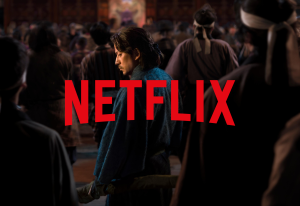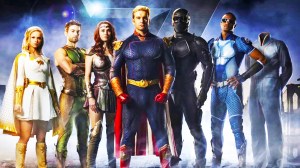“Reach for the sky!” declares a built-in catch phrase of kid-devoted, pull-string sheriff doll Woody (Tom Hanks), a veteran toy whose latest rodeo takes the expression to heart when studio Disney-Pixar dares to go to infinity and beyond with a third Toy Story sequel that exceeds expectations.
Videos by ComicBook.com
For Woody, being a toy isn’t about getting played with: it’s about being there for your kid. But Woody, who was handed down to a now 5-year-old Bonnie (Madeleine McGraw) when college-bound owner Andy moved on from his prized playthings, has fallen out of favor and goes mostly untouched in Bonnie’s closet.
If Woody was a parent letting go of his grown-up kid in 2010’s Toy Story 3, in Toy Story 4 he’s an empty nester. Despite the sharpied “Bonnie” beneath his boot, the cowboy is overlooked and left feeling rudderless by the disinterested and preoccupied soon-to-be-kindergartener, who uses supplies rescued from the garbage to handcraft new best friend Forky (Tony Hale).
A googly-eyed, plastic eating utensil with pipe cleaner arms and popsicle stick feet, the existential crisis-suffering Forky identifies as “trash” and is obsessively compelled to return to his safe space — any garbage receptacle within waddling distance — resisting babysitter-slash-mentor Woody’s urging to accept his place as Bonnie’s favorite toy.
It’s an upheaval, but not quite as much as when shiny new Space Ranger toy Buzz Lightyear (Tim Allen) supplanted Woody as a fresh-out-the-box favorite so many years ago. A trilogy’s worth of growth means Woody is past showing jealousy when unseated as Big Toy on Campus, but his feeling unwanted leaves him desperately searching for purpose: for now it means protecting Forky, recognizing the spork is crucial for helping Bonnie adjust amid kindergarten anxieties.
When Forky goes missing on a family road trip, Woody’s leave-no-toy-behind detour leads to a fateful encounter with long lost sweetheart Bo Peep (Annie Potts), a porcelain shepherdess figurine unexpectedly given away by Andy’s younger sister Molly nearly a decade earlier. Years on the road has transformed the kid-less Bo into Kwai Chang Caine of Kung Fu, a free spirit wanderer and proud Lost Toy who has taken her agency into her brittle hands: now a staff-wielding action hero, Bo finds purpose in connecting lost toys with children.
It’s this theme of toys finding purpose in kids that connects the new crop of characters, introduced when the plot takes us to a roadside RV camp and temporary carnival grounds: there’s laugh-out-loud hilarious plush prize duo Ducky (Keegan Michael-Key) and Bunny (Jordan Peele) — the funniest characters ever dreamed up by Pixar — decades-old defective doll Gabby Gabby (Christina Hendricks), and always-posing Canuck Duke Caboom (Keanu Reeves), a ’70s-era stuntman action figure with a macho facade and crippling insecurity that gives him a hilarious undercurrent of melodrama born by his traumatic past.
All four yearn to be loved by a kid, and because they share this connective tissue (or stuffing), this new crop of toys get much of the focus. Old toys Mr. Potato Head (the late Don Rickles, using archival recordings), Rex (Wallace Shawn), Hamm (John Ratzenberger), Slinky Dog (Blake Clark), as well as mute horse Bullseye and yodeling cowgirl Jessie (Joan Cusack) get little screen time and even less to do.
Once the action leaves Bonnie’s room, toys who played pivotal roles in Toy Story 2 and Toy Story 3 are confined to an RV as Woody, Bo, Duke, Happy Meal-sized police toy Giggle McDimples (Ally Maki), and Ducky and Bunny band together to rescue Forky, who’s been turned captive after fulfilling his purpose as the impetus for the story (and realizing he does want to be loved as Bonnie’s go-to toy).
Even Buzz, who springs into action outside the RV like the superhero toy he is, is less of a key player this time around. (Here he’s guided by his “inner voice” after a misunderstanding leaves the once-deluded spaceman taking advice literally, using phrases programmed into his chest buttons to steer himself in Woody’s absence.)
If this is the last time out of the toy box for Woody and the gang, it’s too bad they spend much of the adventure separated — even if Woody’s crew of misfits are every bit as lovable as the classic toys. Toy Story 4 at times feels like a backdoor pilot — a fifth film isn’t planned, but producers did hint at a possible future spinoff or new direction for the franchise — but at its center is a heartfelt, authentic story for Woody, whose personal and emotional journeys have piloted each of the Toy Story films.
Between Woody’s search for purpose, his philosophical differences with Bo Peep about what it means to be a toy, and the existential dilemma surrounding his dealings with Forky, Woody’s drama is again very human, and beautifully given life by Hanks. One would be hard pressed finding another franchise with this level of consistent quality — particularly impressive after four movies across nearly 25 years.
In delivering a warm, heartfelt, and funny adventure story that is superbly animated and as much an instant classic as its predecessors, first-time feature director Josh Cooley not only captures the magic of the first three Toy Story movies, but overcomes what was the biggest challenge in developing a fourth Toy Story: avoid having the next one feel like an addendum to the Lee Unkrich-directed 3.
Toy Story 3 was the end of the toys’ story with Andy, but not the end of their story — and certainly not the end of Woody’s story. Even Toy Story 4, which reads as the last rodeo for the old cowboy, is more the end of one chapter than the end of a book. The film proves there was enough life left in these old toys for at least one more go, and repeatedly justifies its albeit imperfect existence across its 100-minute runtime. Even after the perfect ending of Toy Story 3, its sequel not only feels earned, but proves to be the necessary next step after that teary-eyed “so long, partner.”
Rating: 4 out of 5
Toy Story 4 opens June 21st.








